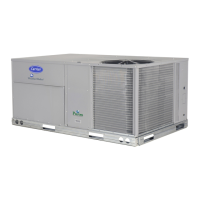38
Step 10 — Make Electrical Connections
50TC 07-14 UNIT ELECTRICAL CONNECTIONS
NOTE: See page 42 for 50TC 16 unit electrical connections.
NOTE: Check all factory and field electrical connections for tight-
ness. Field-supplied wiring shall conform with the limitations of
minimum 63°F (33°C) rise.
Field Power Supply
If equipped with optional powered convenience outlet: the
power source leads to the convenience outlet’s transformer pri-
mary are not factory connected. Installer must connect these
leads according to required operation of the convenience out-
let. If an always-energized convenience outlet operation is de-
sired, connect the source leads to the line side of the unit-
mounted disconnect. (Check with local codes to ensure this
method is acceptable in your area.) If a de-energize via unit
disconnect switch operation of the convenience outlet is de-
sired, connect the source leads to the load side of the unit dis-
connect. On a unit without a unit-mounted disconnect, connect
the source leads to compressor contactor C and indoor fan con-
tactor IFC pressure lugs with unit field power leads.
Refer to Fig. 52 for power transformer connections and the dis-
cussion on connecting the convenience outlet.
Field power wires are connected to the unit at line-side pres-
sure lugs on compressor contactor C and indoor fan contactor
IFC (see wiring diagram label for control box component ar-
rangement) or at factory-installed option non-fused disconnect
switch. Max wire size is #4 AWG (copper only). (See Fig. 49.)
NOTE: TEST LEADS - Unit may be equipped with short leads
(pigtails) on the field line connection points on contactor C or op-
tional disconnect switch. These leads are for factory run-test pur-
poses only; remove and discard before connecting field power
wires to unit connection points. Make field power connections di-
rectly to line connection pressure lugs only.
See Fig. 46.
Fig. 46 — Disconnect Switch and Unit (Sizes 07-14)
Units with Factory-Installed Non-Fused Disconnect
The factory-installed optional non-fused disconnect (NFD)
switch is located in a weatherproof enclosure located under the
main control box (see Fig. 47). The manual switch handle and
shaft are shipped in the disconnect enclosure. Assemble the
shaft and handle to the switch at this point. Discard the factory
test leads (see Fig. 49).
Connect field power supply conductors to LINE side terminals
when the switch enclosure cover is removed to attach the handle.
Field-Install the NFD Shaft and Handle
1. Remove the control box access panel. The NFD enclosure
is located below the control box (see Fig. 47).
2. Remove (3) cap head screws that secure the NFD enclo-
sure front cover — (2) on the face of the cover and (1) on
the left side cover. See Fig. 48.
3. Remove the front cover of the NFD enclosure.
4. Make sure the NFD shipped from the factory is at OFF
position (the arrow on the black handle knob is at OFF).
5. Insert the shaft with the cross pin on the top of the shaft in
the horizontal position. See Fig. 48.
6. Measure from the tip of the shaft to the top surface of the
black pointer; the measurement should be 3.75 to 3.88-in.
(95 to 99 mm).
7. Tighten the locking screw to secure the shaft to the NFD.
8. Turn the handle to the OFF position with red arrow point-
ing at OFF.
9. Install the handle on to the painted cover horizontally with
the red arrow pointing to the left.
10. Secure the handle to the painted cover with (2) screws and
lock washers supplied.
11. Engaging the shaft into the handle socket, re-install (3)
hex screws on the NFD enclosure.
12. Re-install the unit front panel.
Fig. 47 — NFD Enclosure (Sizes 07-14)
WARNING
ELECTRIC SHOCK HAZARD
Failure to follow this warning could result in personal inju-
ry or death.
Unit cabinet must have an uninterrupted, unbroken electri-
cal ground to minimize the possibility of personal injury if
an electrical fault should occur. This ground may consist of
electrical wire connected to unit ground lug in control com-
partment, or conduit approved for electrical ground when
installed in accordance with NEC; ANSI/NFPA 70, latest
edition (in Canada, Canadian Electrical Code CSA [Cana-
dian Standards Association] C22.1), and local electrical
codes.
WARNING
FIRE HAZARD
Failure to follow this warning could result in personal inju-
ry, death, or property damage.
Do not connect aluminum wire between disconnect switch
and unit. Use only copper wire.
COPPER
WIRE ONLY
ELECTRIC
DISCONNECT
SWITCH
ALUMINUM
WIRE

